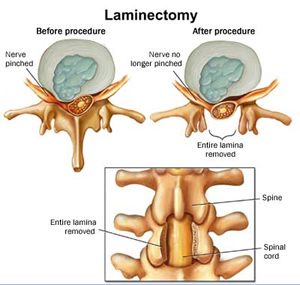Laminectomy is a spinal surgery for the spine where lamina is removed. In this type of laminectomy surgery the lamina (the back part of the vertebra covering the spinal canal) the compression on the spinal cord and nerves is reduced by enlarging the spinal canal.
The pressure on the nerves can be due to a lot of reasons including a herniated disk, spinal arthritis, as well as spinal stenosis where bony overgrowth occurs within the spinal canal. Usually, the surgical treatment is performed in the neck as well as lower back.
Laminectomy is considered as an option when non-surgical treatment options like physical therapy as well medication fails to provide any relief to symptoms the patient is suffering like arthritis spine pain. This surgical treatment may also be considered when the symptoms the patient is suffering starts to degenerate and get worse with time.
Most commonly, laminectomy is done in cases of spinal stenosis so that the pressure on the spinal cord or nerves can be reduced. This type of pressure can cause a lot of discomfort to the patient like pain, muscular weakness, numbness as well as severe pain that can radiate down to the arms and legs. Laminectomy is also a surgical treatment that is done for herniated spinal disk.
Laminectomy Risks
 Although this is a minimally invasive procedure and is considered quite safe, laminectomy can have its set of complications and risks. Potential complications of laminectomy include:
Although this is a minimally invasive procedure and is considered quite safe, laminectomy can have its set of complications and risks. Potential complications of laminectomy include:
- Infection
- Bleeding
- Blood Clots
- Spinal Fluid Leak
- Nerve Injury
Laminectomy Recovery
In some cases patient may go home same day of the surgery however doctors usually keep the patient under observation for several days to watch for complication from the surgery and anesthesia. Doctors usually prescribe pain medications at the incision site.
To help the patient recover better doctors usually advice physical therapy to strengthen your muscles as well as to improve flexibility. Depending upon your job and nature of work you likely will be able to return to work within two to six weeks.
